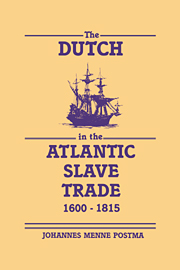Book contents
- Frontmatter
- Contents
- List of tables, figures, and maps
- Preface
- 1 Foundations of the slave traffic, 1600–61
- 2 Curaçao and the asiento trade, 1650–1730
- 3 The Dutch on the West African coast
- 4 Trade and politics on the African coast
- 5 Volume of African exports and origins of slaves
- 6 Organization and mechanics of the trade
- 7 The triangular trade
- 8 The Dutch plantation colonies under WIC monopoly, 1618–1738
- 9 The era of the free trade, 1730–80
- 10 The slaves: their treatment and mortality
- 11 Finances, marketing, and profitability
- 12 The end of the Dutch slave trade, 1781–1815
- Appendixes
- Bibliography
- Index
4 - Trade and politics on the African coast
Published online by Cambridge University Press: 16 September 2009
- Frontmatter
- Contents
- List of tables, figures, and maps
- Preface
- 1 Foundations of the slave traffic, 1600–61
- 2 Curaçao and the asiento trade, 1650–1730
- 3 The Dutch on the West African coast
- 4 Trade and politics on the African coast
- 5 Volume of African exports and origins of slaves
- 6 Organization and mechanics of the trade
- 7 The triangular trade
- 8 The Dutch plantation colonies under WIC monopoly, 1618–1738
- 9 The era of the free trade, 1730–80
- 10 The slaves: their treatment and mortality
- 11 Finances, marketing, and profitability
- 12 The end of the Dutch slave trade, 1781–1815
- Appendixes
- Bibliography
- Index
Summary
When the Europeans first arrived on the coast of western Africa during the second half of the fifteenth century, they found conditions quite different from today. Instead of the sprawling urban centers along the coast, like Lagos, Accra, and Dakar, the centers of population in West Africa were deep in the interior, where states like old Ghana, Mali, and Kanem had controlled vast stretches of the Sahel on the Sahara desert fringes, and where Songay and Kanem-Bornu were to rise to great power status in the sixteenth century. The trade networks of West Africa converged on the caravan routes across the Sahara, which gave rise to the power of these states. By contrast, the coastal regions were thinly populated with small autonomous fishing villages, separated by an endless ethnic variety and dispersed political authority.
One exception to this coastal pattern was the city-state of Benin in south-western Nigeria. Early Dutch visitors described the town with considerable admiration and compared it to contemporary European urban centers in Holland. But on the whole, it was not until the arrival of the Portuguese that several trading centers along the Atlantic coast were developed. This gradually changed the focus of West African trade from the Sahara to the Atlantic, where it tied into the international trading network that was developed and dominated by the Europeans.
- Type
- Chapter
- Information
- The Dutch in the Atlantic Slave Trade, 1600–1815 , pp. 84 - 105Publisher: Cambridge University PressPrint publication year: 1990

